INSECTS ON THE BAY LAUREL IN MY YARD ... ON A SUNNY SUMMER AFTERNOON ...
Nine days ago, I published a post about plant lice in my yard. I noticed them while removing some weeds, I took a couple of photographs, and then in the evening, I prepared a short report to publish here on Hive. The plant lice were of a species that lives, feeds, and reproduces on the bay laurel shrubs and trees. Since I have a couple of pretty big laurel trees surrounded by small shrubs of the same kind, I have plenty of Lauritrioza alacris plant lice too. At the end of that old post, I stated that I'll probably revisit the same corner of my yard in search of material for a post focused on bay laurels and the insects on and around those plants.
Yesterday, I spent most of my afternoon around the Laurus nobilis plants, and today is finally the time to say a few words and show a few shots about that backyard photo expedition. In this opening photograph, you can see three Lauritrioza alacris posing on the edge of the leaf. The leaf is deformed due to the activity of these very small insects. The plant lice are nicely aligned which looks very cool, almost rehearsed and staged, in the photograph. In the following shot ...
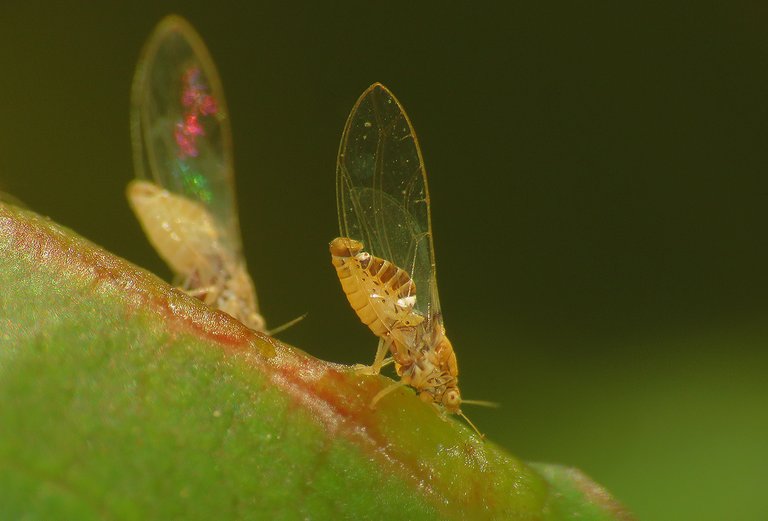
... I came closer with the macro lens. You can see more details of the insect's exterior anatomy but the depth of field is very shallow so only one of those three plant lice is in focus.
Lauritrioza alacris causes the edges of leaves to thicken and roll downwards
forming elongated pouches. Those galls can house up to thirty pale nymphs, covered in white waxy particles. In my experience, they prefer soft young leaves. I mean, I didn't find that information on the Internet, is just something I concluded upon my own observations.
This moth from the Crambidae family was resting on one of the older leaves that haven't been modified by the plant lice activities. It's a fairly small insect but it looks like a giant compared to Lauritrioza alacris. The name of the species is Achyra nudalis. On one of the leaves lower on the plant ...
... I found a jumping spider. This is an Evarcha jucunda female. The family is Salticidae, of course.
Here you can take a look at the setting, this year's shoots around the old bay laurel tree.
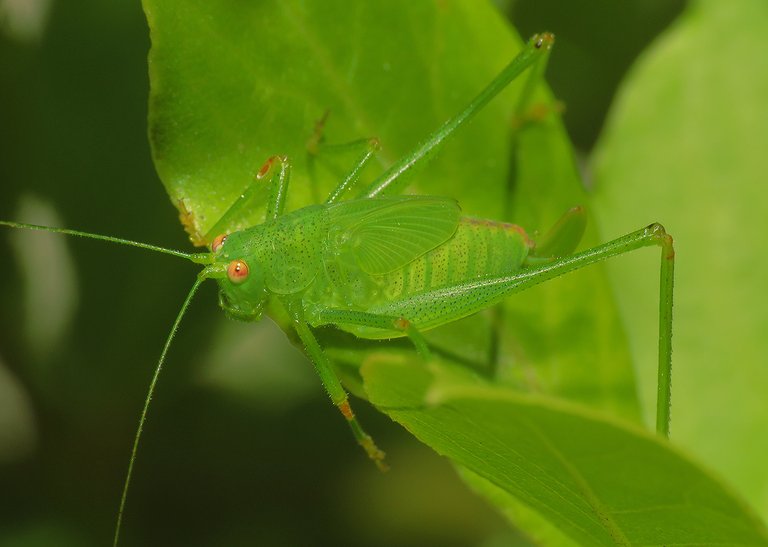
Phaneroptera nana was well-camouflaged in that environment. This is a nymph, a young, immature bushcricket. In the following photograph ...

... I came closer with the macro lens. In this and the previous shot, I used the flash.
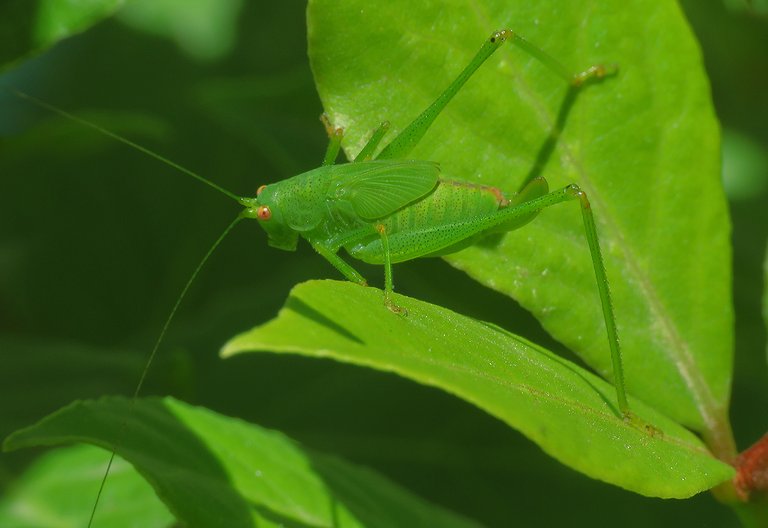
The bushcricket looked better in natural light. And was more distinguishable among the foliage too.
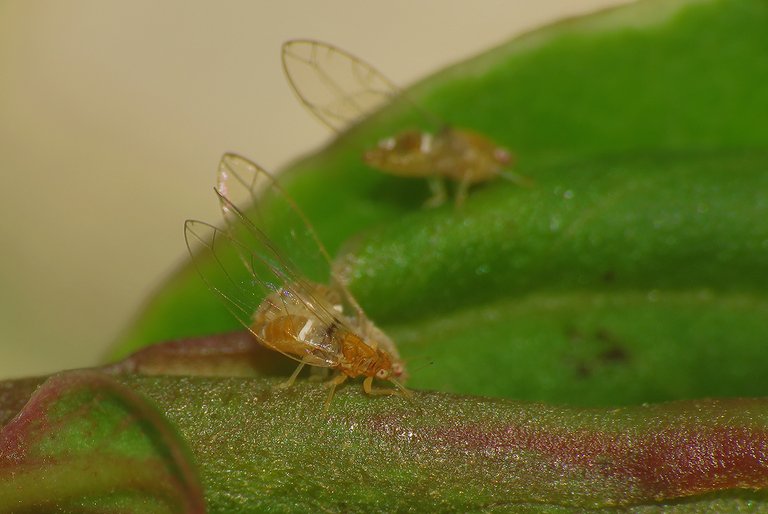
At this point, I was convinced that today's post will be pretty short because after Phaneroptera nana I wasn't able to find any new insect for the next hour or so. And if I didn't take a coffee break, I'll probably wouldn't have anything else to show. While preparing the coffee, a look at the sugar gave me an idea. Why not use something sweet to lure more insects out in the open?
I prepared a dense, sticky mix of sugar and water ...
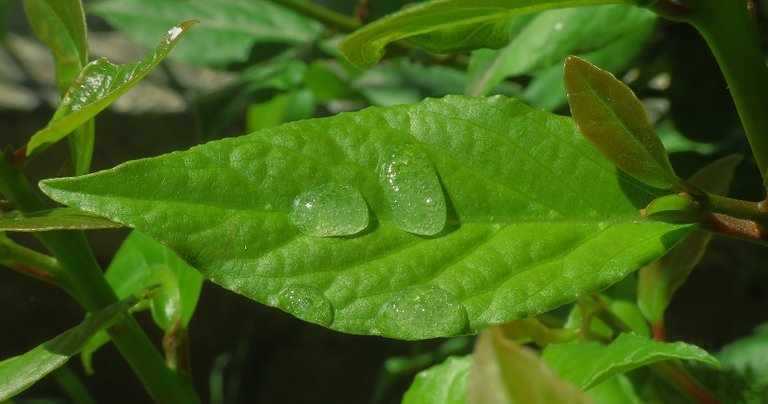
... and sprinkled the leaves with that thing.

Half an hour later ...
... I had plenty of ants to photograph.

When it comes to the name of the species, these are Plagiolepis pygmaea, very small ants from the Formicidae family.

Some minutes later ...
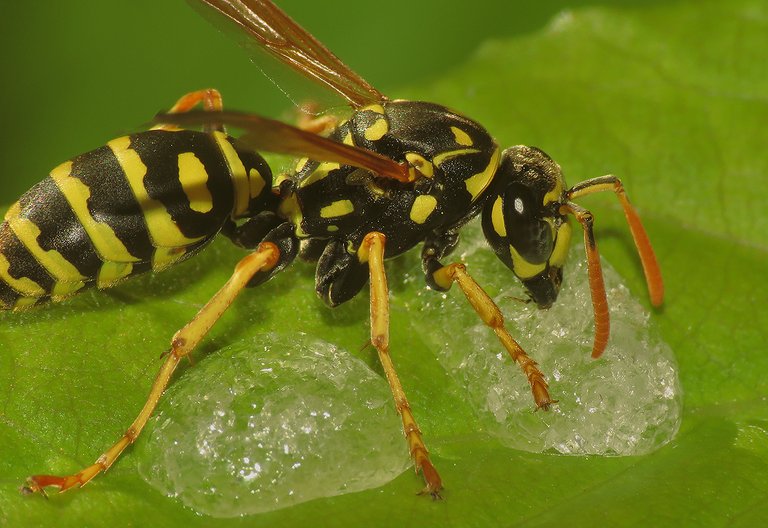
... a paper wasp arrived.
This is the Polistes gallicus, a very common and widespread species throughout Europe.
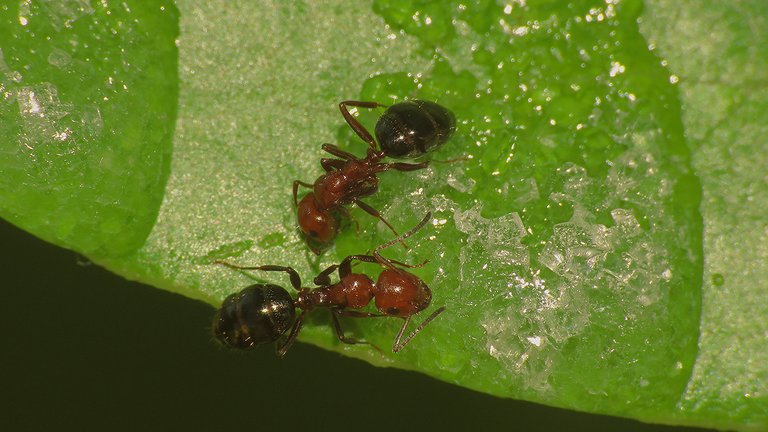
Just like Plagiolepis pygmaea shown earlier in the post, the much bigger ants shown in this photograph also belong to the Formicidae family.
The name of the species is Camponotus lateralis. The semi-dissolved sugar and the semi-translucent ant's body looked very beautiful in natural light.
To photograph the ants in the shade, I used the flash because it was much easier to get good results that way.
You can't see it in this photograph, but the three Lauritrioza alacris shown here were performing what looked like some kind of dance. Unfortunately, I wasn't able to convey that through a single shot but fortunately, I can also record footage with my digital camera. In the following video, you'll see plant lice dancing to a funky tune. Not only that, you'll also see some of the insects shown earlier in the post, but they'll be in motion this time. Have a good viewing.
When it comes to the visual appeal of the mix of sugar and water I used to attract the insects ...
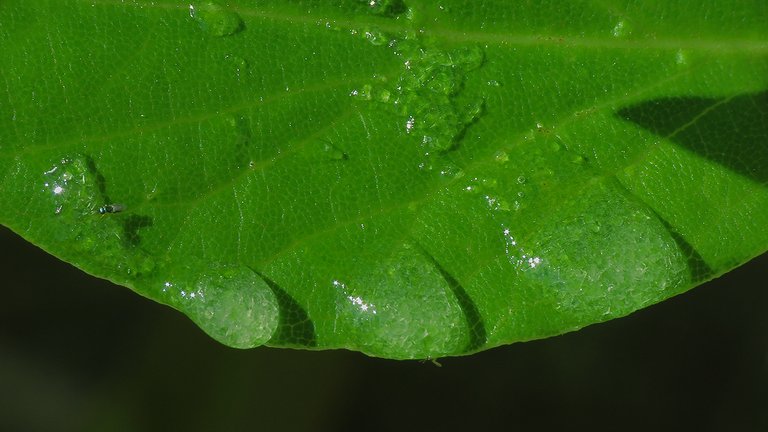
... most of that stuff ended up spread on the foliage in random, not very photogenic shapes.

Most, but not all.

On one of the leaves close to the ground, I found this interesting little sugar ball. Here you can see it photographed in natural light ...

... but I first tried to do it with the flash.
In this shot, taken in natural light, you can see a bit of natural sparkle on the top of the sugary thing.
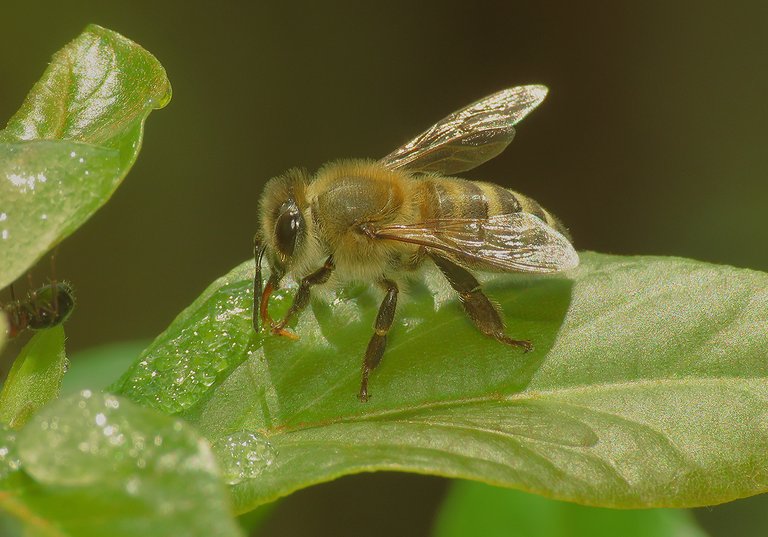
Here you can see a bee that will turn the sugar into a substance with a honey-like taste and consistency. According to what I found on the Internet, to produce real honey, a bee needs nectar.
In this set of four photographs, you can see the same bee on the same leaf, feeding on the same sugar, but the background is slightly different in three of the shots, and in one of them, the bee is in a slightly different pose.
In this photograph, I used only the ambient light.
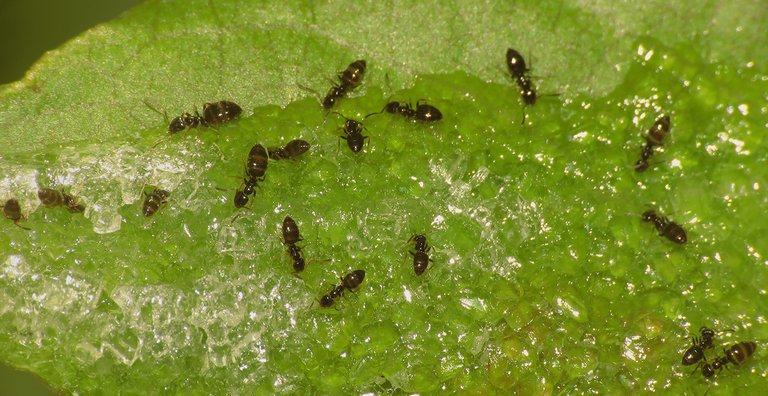
Here you can see another group of Plagiolepis pygmaea workers.
It was a fairly large group.
AS ALWAYS HERE ON HIVE, THE PHOTOGRAPHS AND THE VIDEO ARE MY WORK. THE MUSIC IN THE VIDEO IS SOME LOVELY FREE-TO-USE STUFF I FOUND ON PIXABAY.
Music by Keyframe Audio from Pixabay
Music by orangery from Pixabay
Music by Roman Senyk from Pixabay
Music by Zakhar Valaha from Pixabay
Music by Oleksii Kaplunskyi from Pixabay
The following links will take you to the sites with more information about the protagonists of this post. I found some stuff about them there.
https://www.britishbugs.org.uk/homoptera/Psylloidea/Lauritrioza_alacris.html
https://en.wikipedia.org/wiki/Laurus_nobilis
https://lepiforum.org/wiki/page/Achyra_nudalis
https://en.wikipedia.org/wiki/Evarcha_jucunda
https://en.wikipedia.org/wiki/Phaneroptera_nana
https://www.antwiki.org/wiki/Plagiolepis_pygmaea
https://en.wikipedia.org/wiki/Polistes_gallicus
https://www.antwiki.org/wiki/Camponotus_lateralis
https://en.wikipedia.org/wiki/Western_honey_bee
Just one more thing I wanted to say now when the video is almost encoded and the post will be published very soon. I uploaded the video through Ecency for the first time today. It was a great, seamless experience. Is great to see how Hive grows and develops. While so many things in the Crypto world feel like empty promises and vapid dreams of getting rich through gambling and speculating, here you can express yourself, and develop your skills and talents through blogging, it's so much more than "Crypto as usual".
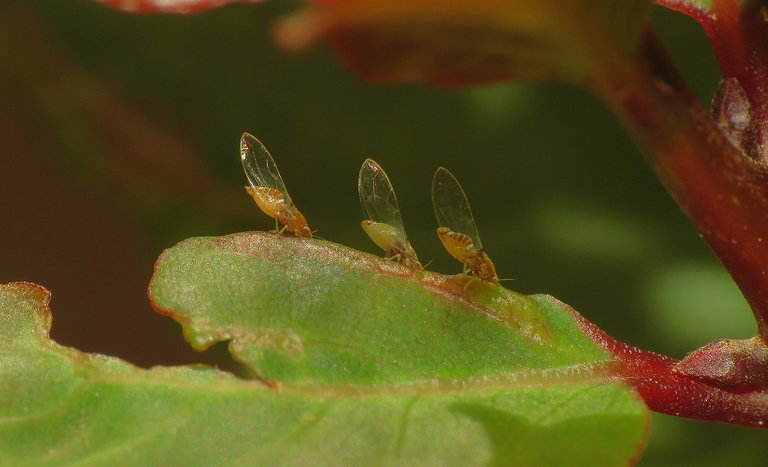
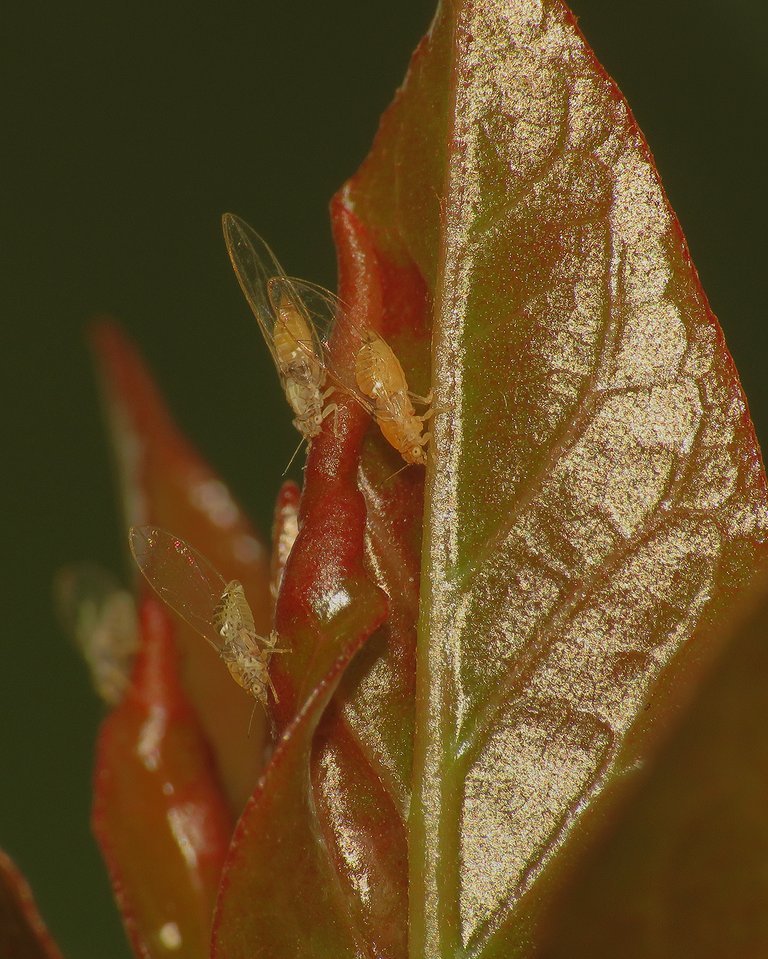
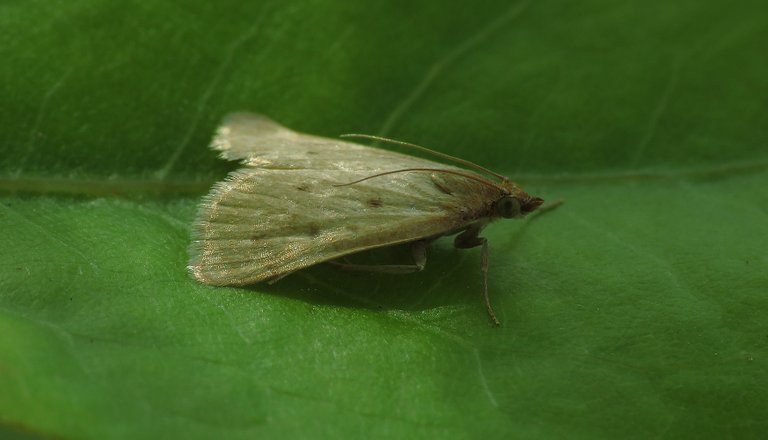
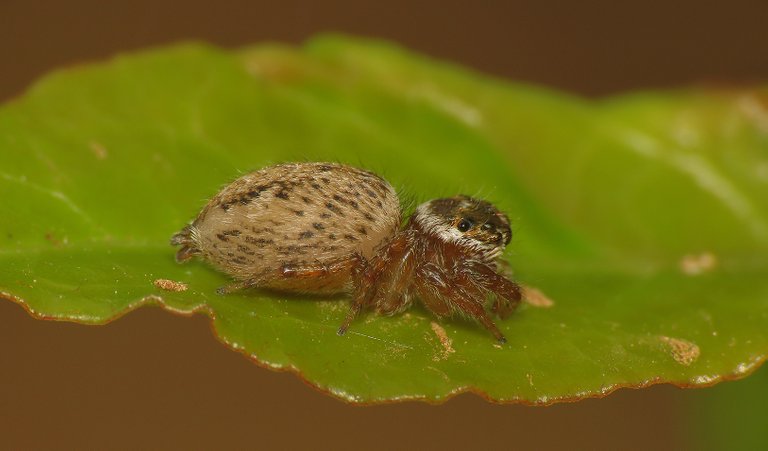
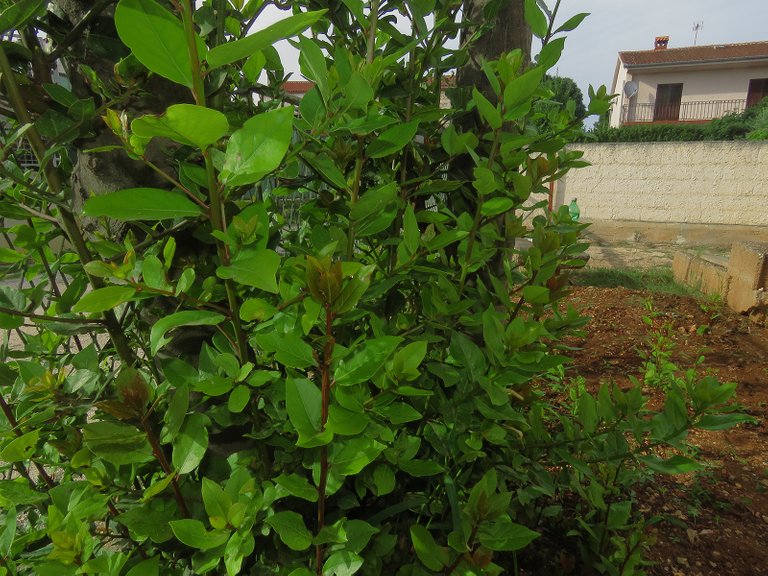

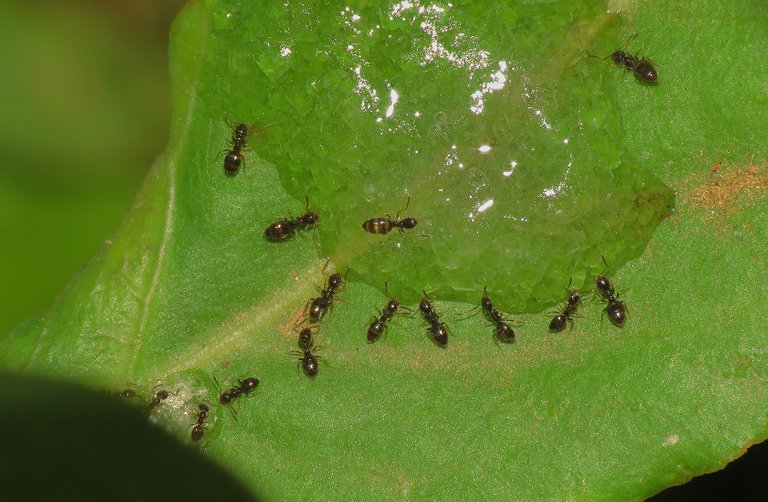

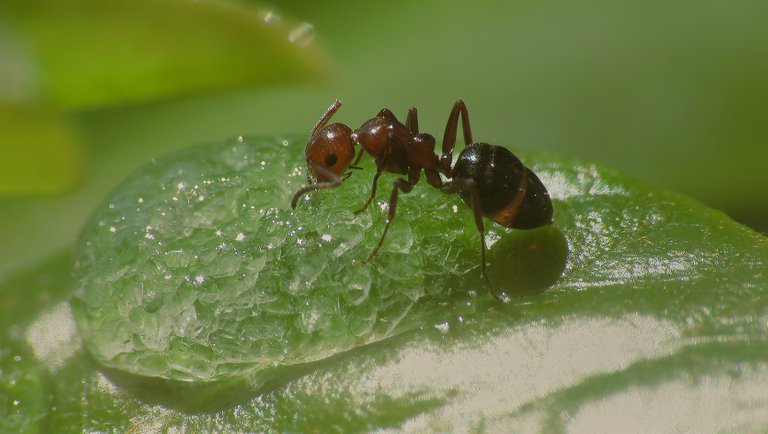



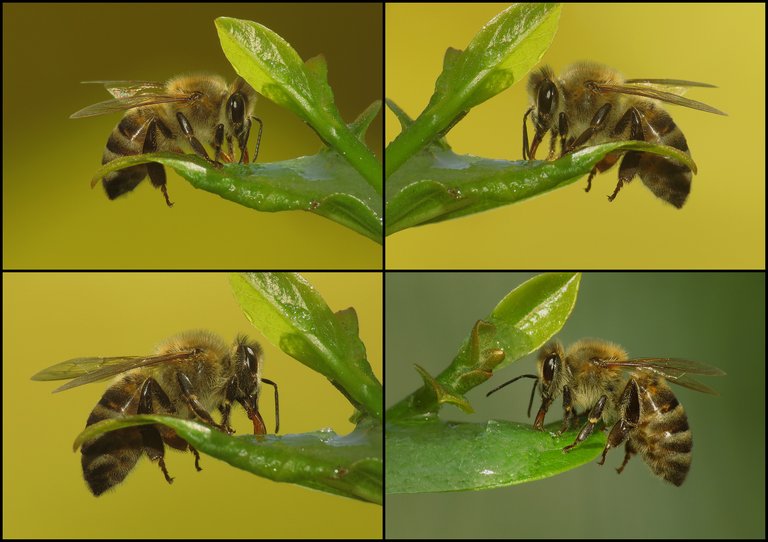
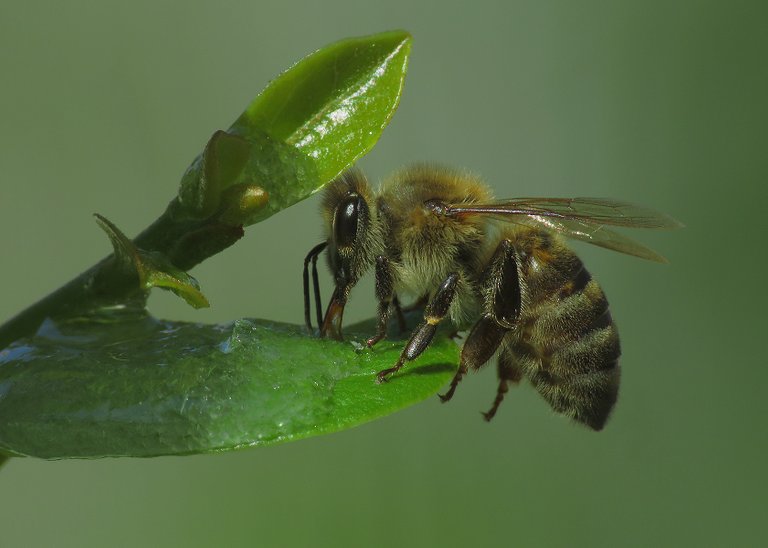

Awesome macro shots @borjan well done 💪🏻
This post was curated by Visual Shots to support your work.
Manually curated by @dimascastillo90
Be part of our Curation Trail
This post has been manually curated by @bhattg from Indiaunited community. Join us on our Discord Server.
Do you know that you can earn a passive income by delegating to @indiaunited. We share more than 100 % of the curation rewards with the delegators in the form of IUC tokens. HP delegators and IUC token holders also get upto 20% additional vote weight.
Here are some handy links for delegations: 100HP, 250HP, 500HP, 1000HP.
100% of the rewards from this comment goes to the curator for their manual curation efforts. Please encourage the curator @bhattg by upvoting this comment and support the community by voting the posts made by @indiaunited.
Such a wonderful collection of the gems of Creation ... wonderful!
I enjoyed the pics of the lice all lined up, but even as cute as they are, I can't help but dislike them for the damage they cause to plants. I've never thought about trying to bait insects in with sugar water. Knowing my luck, I'll attract ALL the wasps in the neighbourhood and then be mobbed by them when I try to take photos 🤣
You got awesome shots.
🙂 Yes, you never know what the sugar will attract. Many very different species like sweets.
Very nice and green photos of your plants. But I hope I don’t have any lice on my plants!
Those tiny snails ate all the leaves on the young roses! Only stems were left bear! So, no lice would be a boon.
That wasp looks quite threatening. So, I won’t try your trick to attract more insects. But I do want to attract bees to my garden. We have no bees nests in our garden for several years. The farmers around the area used too much pesticides. 🙀
Yes, here also the bees are getting rarer every year.
Jumping spiders are one of the cutest creatures in existence! They are so observant too, if you pay attention to them closely. Very cool post my friend.
True 🙂 They really have surprisingly cute faces.
These photos are an amazing collection of Ants, Bees & plant Lice in Today's post. A close up view of the insect World your might say. A hairy Spider is quite scary to me, but especially one that jumps !LOL
Amazing macro shots (especially the Lice trio). Perfection 👌
lolztoken.com
The next day she locked me in the cellar
Credit: playbyhive
@borjan, I sent you an $LOLZ on behalf of fun.farms
(4/10)
Farm LOLZ tokens when you Delegate Hive or Hive Tokens.
Click to delegate: 10 - 20 - 50 - 100 HP
Yes. 😄 A spider from the Salticidae family is a great natural jump scare.
Wow man! Perfect macro shots! Lice on reddish leaves look awesome and the bush-cricket can't bee seen without focus, I guess. They are perfectly camouflaged. Those bees are trying to gathering honey, while the ants are ready to eat it up in sugar form...🤣🤣
The video is pacific! Insects kept moving to the tune..🥰
The details you've managed to capture in these insect photos are simply stunning. Each shot reveals a world of textures, colours, and patterns that often go unnoticed.
The Evarcha jucunda female spider almost looked like a stuffed animal instead of a spider. Cool idea, the sugar. Much prefer your close-up of the wasp, than seeing it that close in real life. :))
🙂
The truth is that we all are very lucky to have you with us and who has so much knowledge about these things and now our knowledge is also increasing. Thank you very much.
Thank you. 🙂 This is a great compliment.
https://twitter.com/lee19389/status/1693968138235228519
#hive #posh
I have a question. Do you think that it is possible to eliminate plant lice in yards forever?
Also, your pictures are beautiful
I don't know. 😂 I don't know much about that pest elimination stuff. I like to have more insects for photography so I never tried to eliminate them.
Those are wonderful insect. Those are looking amazing. I have seen first insect maybe first time.
https://twitter.com/LovingGirlHive/status/1693923527311941978
You successfully lured the insects. Beautiful photos.
These are really great and amazing pictures I must confess
Very nice for your photography sir. @borjan
very nice insect pictures that friends display.
I think you are insects friendly but I don't like them. They irritates me alot.